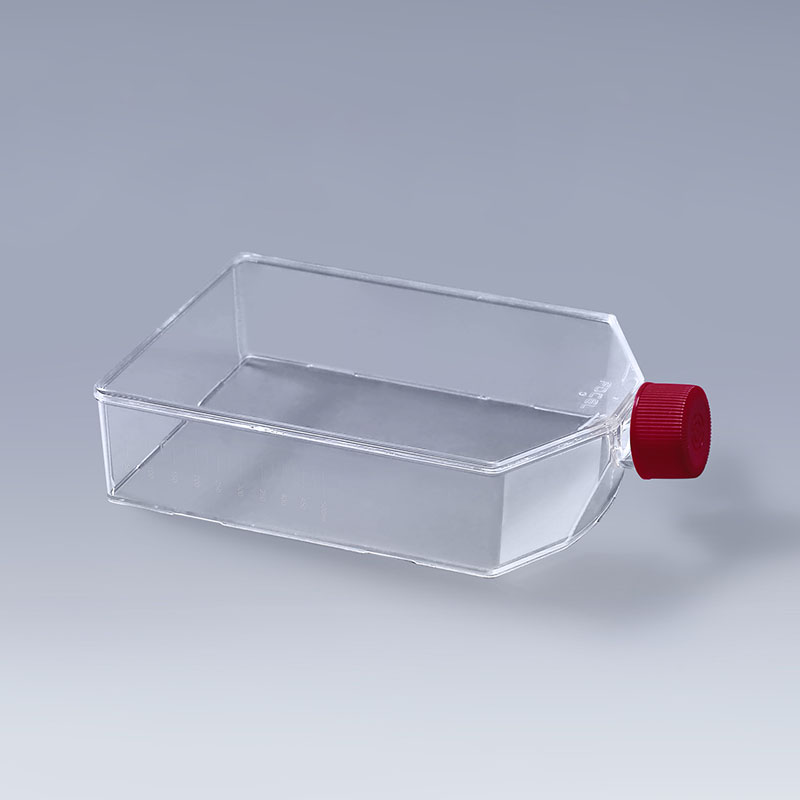In cell culture experiments, cell culture flasks play a crucial role as one of the basic experimental consumables.Especially for demanding cell types and complex culture environments, the right consumables can effectively reduce experimental variables and help researchers better observe, analyze and maintain the cell state.In this article, we will focus on several key features of cell culture flasks and provide you with suggestions for choosing the right flasks.
1. Transparency: a key factor in observing cell state
The transparency of cell culture flasks is an important indicator for evaluating their quality.Most cell culture flasks are made of highly transparent polystyrene material, which is designed to allow researchers to clearly observe cell growth, morphological changes and culture status.Whether you are culturing suspension or adherent cells, transparent flasks make it easy to monitor cell proliferation and health in real time, so you can adjust the culture conditions in a timely manner to avoid overgrowth or cell death.Choosing bottles with high transparency and no impurities can ensure the clarity of observation and help the accuracy of data.
2. Surface treatment: the decisive factor of cell attachment
Cell attachment is one of the key factors affecting the experimental results.Different types of cell culture bottles have obvious differences in surface treatment, and common surface treatments include TC (tissue culture treatment) and un-TC treatment.At the same time, PC's high transparency and free coloring provide more possibilities for the design of Erlenmeyer Shake Flasks.The enhanced PC material has a UL temperature index of 120~140°C, ensuring the stable use of Erlenmeyer Shake Flasks in a wider temperature range.
Therefore, when choosing cell culture flasks, the type of cells used in the experiment must be clearly defined to ensure the appropriateness of the culture conditions.
3. Bottle design: optimize the operation process and enhance the experimental efficiency
The bottle design of cell culture flasks directly affects the convenience of experimental operation and culture efficiency. The wide neck design has significant advantages in operation, which can ensure no dead-angle contact and facilitate the use of pipettes and cell scrapers and other tools. In addition, the ventilation holes at the bottom of the bottle can accelerate gas exchange, help the bottle quickly return to room temperature, and reduce the cellular stress caused by the temperature difference, thus ensuring the stability of the experiment and the healthy growth of the cells.

4. Lid design: ensure gas exchange and stability of culture environment
The lid of the cell culture flask is the key part to control the culture environment, usually there are two choices of breathable lid and sealed lid. Breathable lids are suitable for culture environments that require a high level of gas exchange, such as most adherent or suspension cells that require oxygen exchange. Sealed lids, on the other hand, are more suitable for some specific culture conditions, such as experiments requiring lower humidity and gas exchange. Choosing the right lid design ensures the stability of the culture environment and reduces the risk of external contamination that may occur during the culture process.
In cell culture experiments, choosing the right cell culture flask is critical to the success of the experiment. Different cell types, experimental environments and operational needs require us to choose the right bottle size, surface treatment and lid design. Whether it is to increase cell attachment or optimize gas exchange, the choice of details can significantly improve the efficiency of the experiment and the reliability of the results.
As a professional provider of consumables for biological experiments, Fudo Cells is committed to providing researchers with high-quality cell culture flasks. Our cell culture flasks are made of high-quality transparent materials with stable surface finishes and convenient designs to meet a variety of experimental needs. Whether you are engaged in basic scientific research or industrialized research, Fudao Cells can provide you with customized experimental solutions to help your scientific research achievements to a higher level.
The FAI climbed 5.9 percent year-on-year in the first 11 months of 2018, quickening from the 5.7-percent growth in Jan-Oct, the National Bureau of Statistics (NBS) said Friday in an online statement.
The key indicator of investment, dubbed a major growth driver, hit the bottom in August and has since started to rebound steadily.
In the face of emerging economic challenges home and abroad, China has stepped up efforts to stabilize investment, in particular rolling out measures to motivate private investors and channel funds into infrastructure.
Friday's data showed private investment, accounting for more than 60 percent of the total FAI, expanded by a brisk 8.7 percent.
NBS spokesperson Mao Shengyong said funds into weak economic links registered rapid increases as investment in environmental protection and agriculture jumped 42 percent and 12.5 percent respectively, much faster than the average.
In breakdown, investment in high-tech and equipment manufacturing remained vigorous with 16.1-percent and 11.6-percent increases respectively in the first 11 months. Infrastructure investment gained 3.7 percent, staying flat. Investment in property development rose 9.7 percent, also unchanged.
 English
English


















































